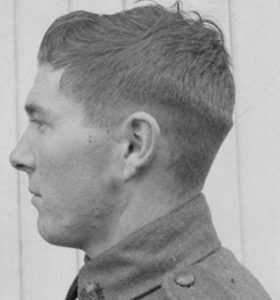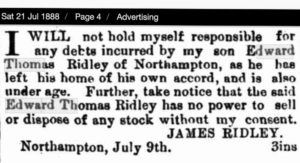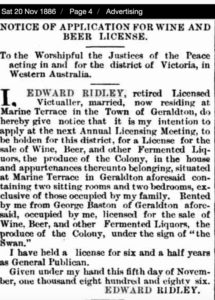The Soldier's Details

- Surname:
- Cripps
- First Name:
- David Charles
- Nick Name:
- Davey
- Rank:
- Private
- Regimental #:
- WX15783
- Company:
- 'A' Company, Headquarters Reinforcement.
- Enlisted:
- 13.08.1941
- DOB:
- 15.12.1921
- Place of Birth:
- Geraldton, Western Australia
- Father's Name:
- David Williams Cripps
- Mothers's Name:
- Mary Grace Cripps (nee Ridley)
- Religion:
- Methodist
- Pre-war Occupation:
- Labourer
- Memorial:
- Epitaph, Labuan Memorial, Panel 18, Age 22.
- Singapore:
- Selarang Camp Changi, River Valley Road Transit Camp (prior to departure to Japan)
- Force:
- 'A' Force Burma, Green Force, No. 3 Battalion
- Camps Thailand:
- Tamarkan
- Camps Burma:
- Victoria Point, Thetkaw, Kendau, Meiloe, Aungganaung
- POW#:
- 1502
- Japan:
- Rakuyo Maru Party, Kumi No. 35
- Cause of Death:
- Lost at Sea
- Place of Death:
- South China Sea
- Date of Death:
- 12.09.1944
General Description
Cripps enlisted at Claremont on 13 Aug 1941, joining General Reinforcements. He recorded his mother Mary Grace Ash NOK – she was then residing Northampton, but soon after updated to 601 Murray Street, Perth.
He was granted pre-embarkation leave 27 Sep to 4 Oct 1941. On returning to Northam he was Taken on Strength the following day 5 Oct 1941 to Woodside, South Australia,
He joined 2/4th MGB’s A Coy HQ with other Northampton boys and reinforcements Randall, Osborne and Don Sutherland.
Osborne (died 15 Feb Buona Buona Vista) and Sutherland (died 15 Feb Tanglin Halt, Buona Vista) were KIA at Singapore in 1942.
David Cripps’ war medals can be found at Geraldton RSL’s Collection. Another soldier from 2/4th also has his medals with their collection: WX8384 Robert Gordon Henderson who remained in Singapore throughout the war and died in Geraldton in 1980.
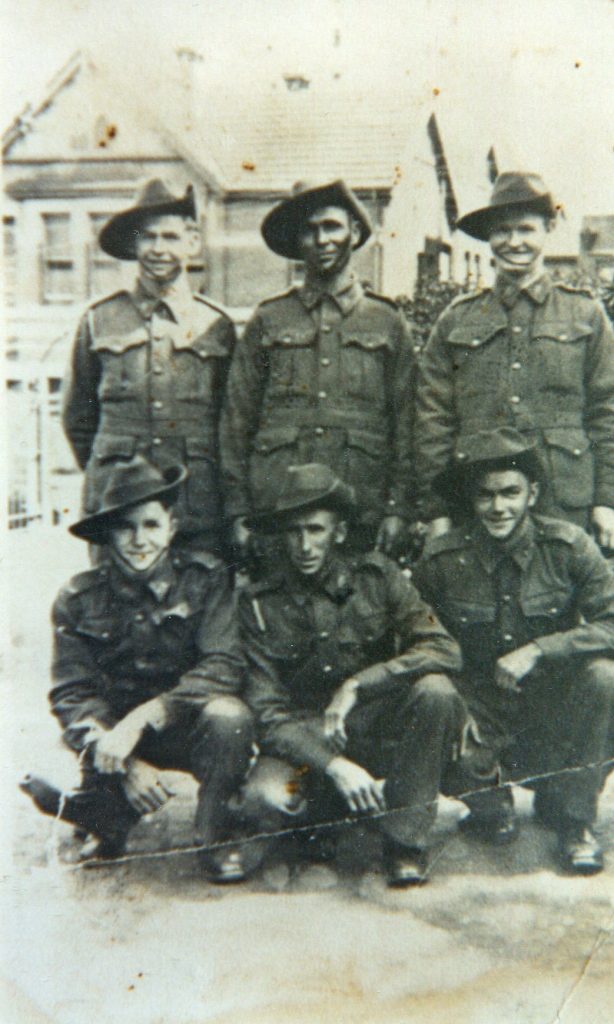
Read about ‘A’ Force Green Force No 3 Battalion
David Cripps was selected for Japan 27 March 1944 with Kumi 35 while he was at Tamarkan, Thailand.
The ‘Rakuyo Maru’ party as they were to become known as, was sent by train from Tamarkan via Bangkok to Phom Penh, French Indo China. They made their way to Saigon and although the Japanese attempted several times to have them sail for Japan from this coastline, it took several months before the Japanese realised it would be futile with the American submarine blockade which had successfully sunk most Japanese shipping attempting to leave.
The POWs were put to work mostly around the docks and other areas of Saigon waiting for a ship.The Japanese eventually returned the POWs to Phom Penh to take train trip to Singapore via Bangkok.
At Singapore the POWs were accommodated at River Valley Road Transit Camp and sent out to work, mostly around the wharves, before they finally embarked on ‘Rakuyo Maru’ at Keppell Harbour and sailed about 10th September 1944. The whole process from when the men were selected for Japan in March 1944 had taken about 6 months.
David Charles Cripps WX15783.
One or two days after ‘Rakuyo Maru’ sank in the South China Sea on 12th September 1944, and during a late afternoon, an exhausted David Charles Cripps aged 22 years, tragically lost his life when he slipped off the raft he managed to board having miraculously survived the sinking of the ‘Rakuyo Maru’. He was 22 years old.
Peter Cripps nephew David Charles Cripps, organised and held a service in Geraldton on 12 September 2013 in honour of his uncle and his service to Australia during WW2. 59 years previously his uncle, a POW on-board ‘Rakuyo Maru’ which was sailing in a convoy from Singapore en-route to Japan was torpedoed by US submarines. During the following days hundreds of POWs either perished or drowned in the South China Sea near Hainin Island. The astounded crew of the very same submarines that had attacked the convoy picked a very fortunate small number of men up several days later. The crews were completely unaware the convoy was carrying 100s of POWs to work in Japan. The Japanese chose not to identify their human cargo.
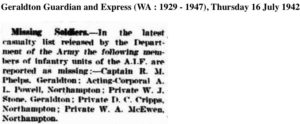
CRIPPS, Private, DAVID CHARLES, WX15783, A.I.F. 2/4 M.G. Bn., Australian Infantry. 12 September 1944. Age 22. Son of David Williams Cripps and Mary Grace Cripps, of Northampton, Western Australia. Panel 18.
Labuan Memorial, Malaysia.
Read Rakuyo Maru story
Read about the enlistments from Northampton.
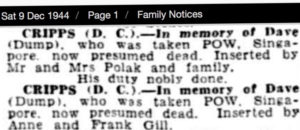


Above: David W Cripps and Mary (Grace) Ridley.
Below: wedding announcement – Miss Grace Ridley known as Coonon . Grace’s mother remarried following the early death of her father Edward Ridley in 1902.
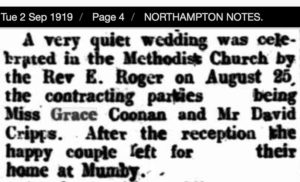
Davey Cripps parents David William Cripps and Mary (Grace) Ridley married in 1919. David William Cripps died unexpectedly in September 1924 aged 38 years. Davey’s grandfather Thomas Charles Cripps had died the previous year, in April 1923.
David William Cripps enlisted WW1 however was invalided home with a serious allergy. William’s two brothers were turned away from enlistment with illness, so their father Thomas Charles Cripps aged 61 years enlisted in their place. ***
Davey Cripps – his father and grandfather were no longer alive when he enlisted. He was only child of Mary (Grace) Cripps (nee Ridley)who later married Bertie Ash.
About 1927, Mary (Grace) Cripps remarried to Bertie Harold Ash. Bertie Ash was brother of 2/4th’s WX16279 Eric Francis Osborne’s mother. Eric ‘s mother Edith Beatrice Osborne (nee Ash) died young in 1926, leaving 4 young children. Eric was the youngest of four sons who were placed into care – believed to be an orphanage at Geraldton.
Bertie Harold Ash’s wife had died 1926 leaving four young children.
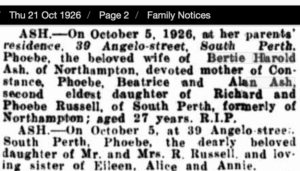
Grace Cripps’ marriage to Bertie Ash ended in divorce June 1948 on account of Ash’s desertion.
Grace died in Geraldton 1961 – she had lived through much death and heartache. It was Grace who left her son’s war medals with the RSL Geraldton.
Eric Osborne was KIA 15 February 1942 Buona Vista, Singapore aged 19 years. He also joined ‘A’ Coy HQ with Cripps, Sutherland, Randall etc. from Northampton.
Mary (Grace) Cripps (nee Ridley, aka Noonon) was born 1897 at Northampton to parents Edward Thomas Ridley and Beatrice Jane Sims who married 1892. Edward Ridley died in an accident in 1902 leaving behind four young children. Grace was about 5 years old.
Beatrice Jane Ridley remarried to James Pearce Coonan. They had another three children.
Edward Thomas Ridley was born Greenhills, WA in 1870 to parents James and Charlotte Ridley.
Below: A rift develops between James Ridley and his son.
We cannot be decisive about below notice – whether it is this Edward Ridley is one and same man or in fact another relative.
Grace Cripps’ sister Gertrude (Ellen) died 1931 aged 22 years, followed a few months later her mother Beatrice Coonan (nee Sims) died in 1931.
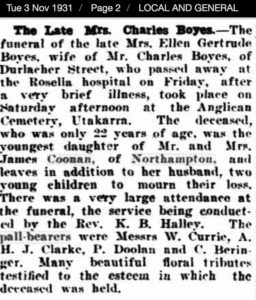

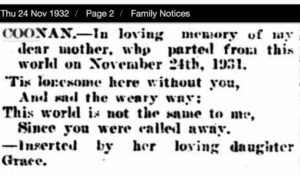
Below: Edward Thomas Ridley died in an accident in 1902 leaving his wife with four young children.
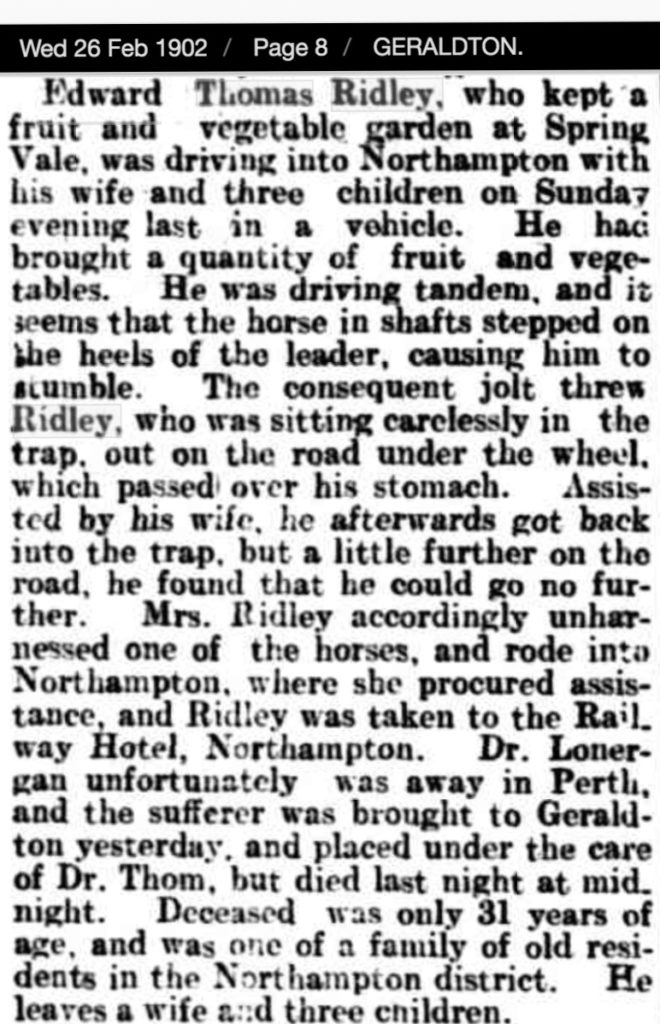
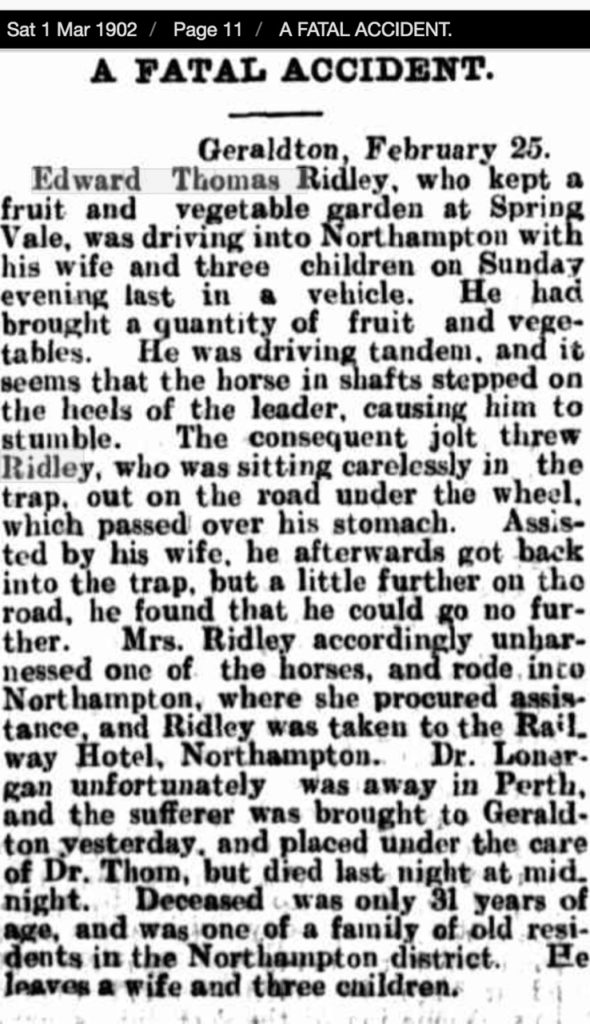
Below from Geraldton Advertiser 25 February 1902


Below, is a write up about the returning Private Charles Cripps from WW1. Charles Cripps died 6 years later.
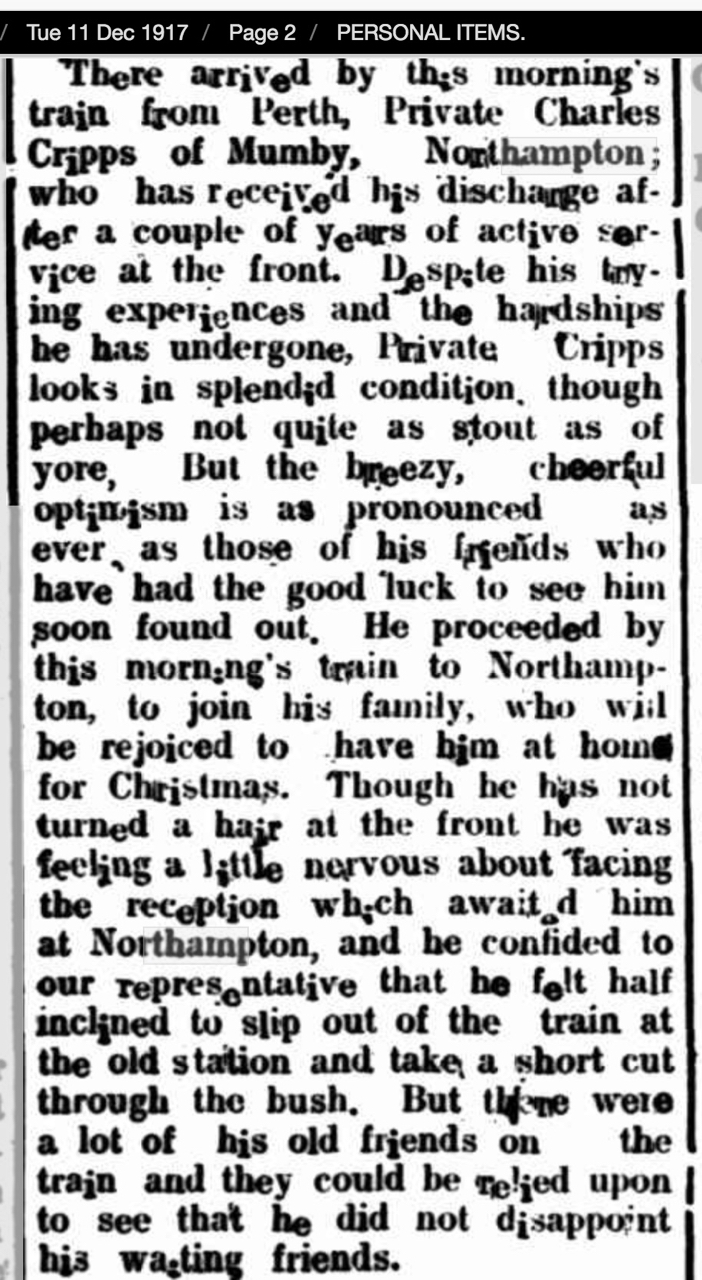
Below: the good news May 1943 – Cripps and Randall were reported POWs when previously it was reported they were missing.
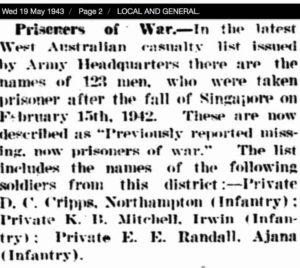
Below: Their families learn the tragic news they will not be returning home.
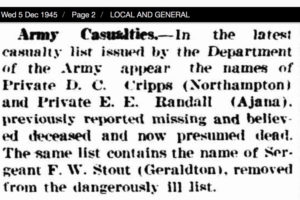
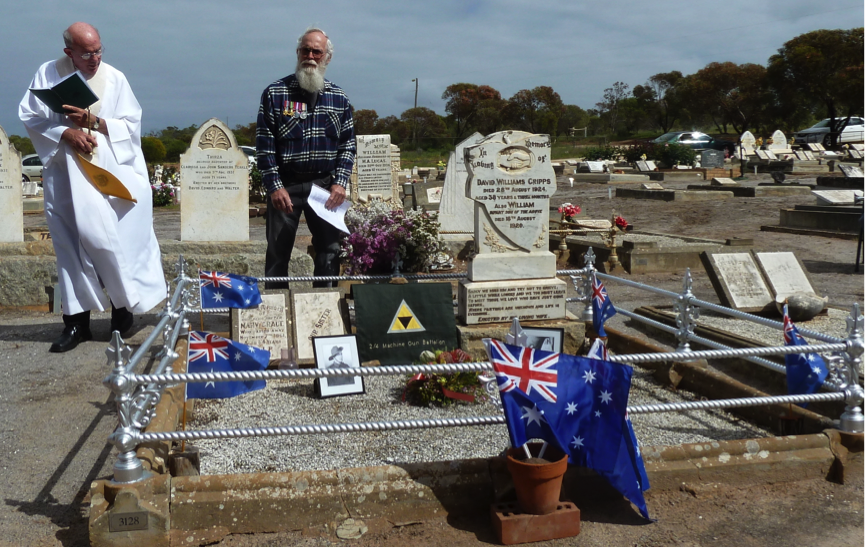
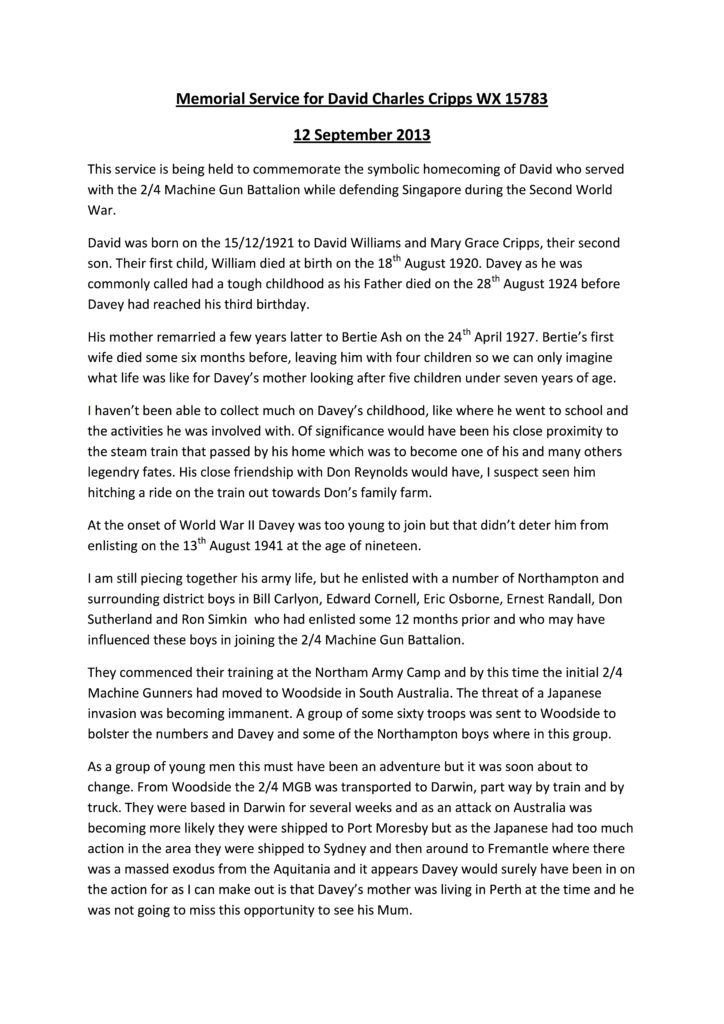
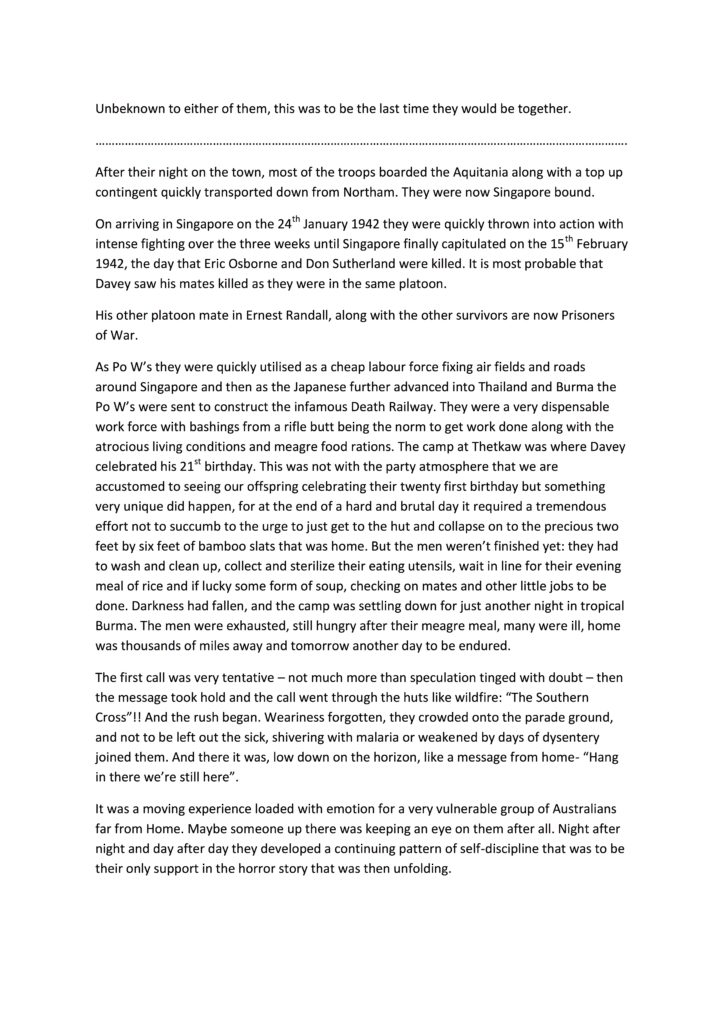
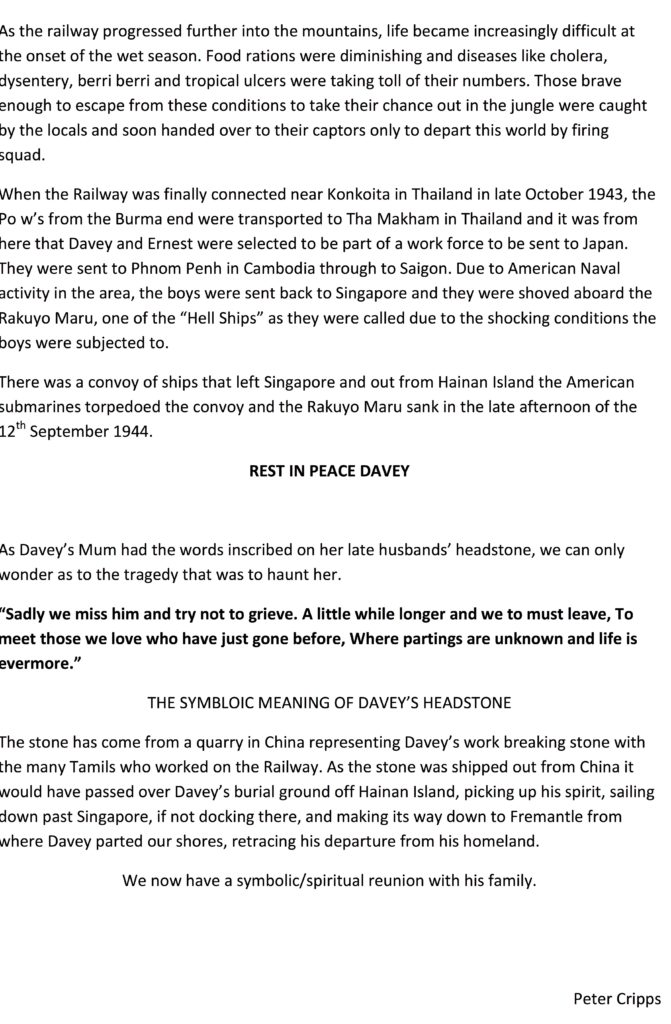
***. Below and interview on ABC Radio with granddaughter of
He was born in England in 1854 and was just 16 when he ran away from home to Australia.
It was a bold move that would eventually see him swap a team of horses for a 16-hectare farm lot north of Geraldton in Western Australia.
In August 1915 Charles signed up to serve in World War I. He was 61-years-old but told recruiters he was 45.
His great granddaughter Jenny MacKay has documented the Cripps family history.
“I don’t know how he got away with it because looking at the photos of him he’s got a little moustache, and some photos actually show that he’s got little grey sideburns. He certainly doesn’t look 45 in his photos,” she said.
Charles Cripps had three sons, but all were medically unfit to serve.
“My great-grandfather had gone into Northampton prior to going to war, but because the boys weren’t well, great-grandfather wanted to represent the Cripps family,” she said.
“Charles left Australia in 1915, basically on his 61st birthday was when he signed up, he went to Egypt and then was sent to the Western Front in France and Belgium. What he saw I don’t know, but we can just imagine.”
Two years later Charles Cripps wrote to his commanding officer and requested to be discharged and return to the farm. In this request he confessed he was 63.
“It wasn’t until late 1917 that he actually came back to Northampton,” said Mrs MacKay.
“As the generations have gone on and as I’ve done the family history, I believe that we’re all very, very proud of our great grandfather. The fact that we are now reaching the age that he was when he went away to war, so we sort of start to think, ‘Wow he went away at 61, that’s really amazing’.”
The original block of land purchased by Charles Cripps was expanded and became Mumby Farm, a well regarded land holding in the Northern Agricultural Region. It remained in the Cripps family for over 100 years.
12 September 2016
Speech transcript
WX15783 Private David Charles Cripps, 2/4th Machine Gun Battalion
Died at sea (Rakuyo Maru)
12 September 1944
Today we remember and pay tribute to Private David Charles Cripps.
David Cripps was born in Geraldton, Western Australia, on 15 December 1921, the son of David and Mary Cripps.
His father was a farmer who had enlisted for service in the First World War, but was given a medical discharge after suffering from chronic dermatitis. The elder David Cripps died when David was just three years old. His mother later remarried, but had no more children.
Young David Cripps grew up in Northampton, where he attended school at Bowes.
On 13 August 1941, at the age of 19, David Cripps enlisted for service in the Second Australian Imperial Force. Soon after joining his training unit, he developed laryngitis. After a week of recovery, he was back in training.
In early October he was allotted to reinforcements to the 2/4th Machine Gun Battalion. Largely consisted of men from Western Australia, the battalion had been established to provide direct fire support to infantry brigades of the 8th Division.
After taking the journey to Darwin, where his battalion was undertaking garrison duties following the Japanese landings in Malaya, Private Cripps embarked for overseas service on 30 December 1941.
Following a Japanese attack on Rabaul, the convoy carrying Cripp and his battalion turned and sailed to Sydney, and then Fremantle, finally reaching Singapore at the end of January 1942. Here it was hastily deployed in support of the 22nd and 27th Brigades in the north-west of Singapore island. Heavily engaged and outnumbered around the landing beaches, over the course of the week it was pushed back towards the city.
After days of air raids, the Japanese attacked Singapore on the 8th of February, crossing the Johore Strait and attacking along the 22nd Brigade’s front and the 27th Brigade near the Causeway.
The machine-gunners suffered heavily. In early February, 137 men were listed as killed or missing, 106 wounded, and 24 described as having “shell shock”. These casualties constituted almost one-third of the battalion.
Despite this, the battalion kept fighting, sending out patrols until receiving the order to surrender. Despite orders to surrender weapons and ammunition, the men destroyed the majority of their equipment before being marched to Changi gaol.
Cripps was one of the 3,000 men who was part of A Force, the first Australian group to leave Singapore for Burma. After sailing in the Celebes Maru on 15 May, a third of A Force disembarked at Victoria Point in the far south of Burma. Another third were sent to Mergui and the remainder to Tavoy, all tasked with building air fields.
At first the conditions for prisoners were adequate, if basic. Japanese control was fairly lax and a relatively good working relationship with the Japanese was established. Despite this, prisoners who attempted to escape were executed without trial.
In September 1942 the Australian prisoners were consolidated at Thanbyuzayat to begin work on the Burmese end of the Burma–Thailand Railway. As work went on, conditions for the prisoners became worse. Without adequate food and medical supplies many were falling ill. Their condition worsened in 1943 as cholera, smallpox, dysentery and malaria broke out and malnutrition became endemic. Relentless labour on inadequate rations in a deadly tropical environment caused huge losses. By the time the railway was completed in October 1943, at least 2,815 Australians, over 11,000 other Allied prisoners, and perhaps 75,000 other forced labourers were dead.
After the railway was finally completed in October 1943, Cripps and the other surviving prisoners were gradually returned to Singapore.
While the suffering and deprivations of the Burma–Thailand Railway are well known, the most dangerous period in a prisoner’s life was travelling in captivity. Over-crowding, sickness, disease, and the dangers posed by Allied submarines caused stress and anxiety. Conditions on board ships were severe: over 1,000 prisoners might be crammed into spaces suitable for a few hundred and given little food, fresh water, or adequate sanitation facilities. The prisoners of war called these transports “hellships”.
On the 6th of September, David Cripps was among the 1,318 Australian and British prisoners of war assembled on the hellship Rakuyo Maru which was part of a convoy bound for Japan.
On the morning of 12 September the convoy was attacked by American submarines in the South China Sea. Rakuyo Maru was sunk by USS Sealion II. Kachidoki Maru, carrying British prisoners of war, was hit by USS Pampanito.
Prisoners able to evacuate the ships spent the following days in life rafts or clinging to wreckage in open water. About 150 Australian and British survivors were rescued by American submarines. A further 500 were picked up by Japanese destroyers and continued the journey to Japan.
David Cripps was one of 1,559 Australian and British prisoners of war killed in the incident.
He was 22 years old.
With no grave but the sea, today his name appears on the Labuan Memorial, which commemorates over 2,000 men who died while prisoners of war and who have no known grave.
His name is listed on the Roll of Honour on my left, among almost 40,000 Australians who died while serving in the Second World War.
This is but one of the many stories of service and sacrifice told here at the Australian War Memorial. We now remember Private David Charles Cripps, who gave his life for us, for our freedoms, and in the hope of a better world.
Duncan Beard
Editor, Military History Section

Please view this AWM video of the above and the 75 years since the sinking of ‘Rakuyo’ Maru.
Camp Locations:
- River Valley Road Camp - Singapore
- Selarang Camp Changi - Singapore
- Tamarkan, Tha Makham 56k - Thailand
- Aungganaung,105Kilo - Burma
- Kendau, Kandaw, 4 Kilo - Burma
- Meilo, 75 Kilo, 340k - Burma
- Saigon - French Indo China
- Victoria Point, Kawthoung - Burma. \'A\' Force, Green Force No. 3 Btn
- Thetkaw 14 Kilo - Burma


